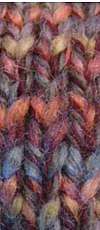Continental knitting
Knitting with the yarn in the hand opposite the working needle (i.e. the left hand if the knitter is right-handed) is commonly referred to as Continental knitting, German knitting, European knitting, or left-hand knitting. The term 'left-hand knitting', however, is discouraged by left-handed knitters because it leads to misunderstandings. Unlike English knitting, the tip of the working needle is used to hook the yarn and bring it forward; the motion is thus sometimes known as picking. Continental knitting can be done at a faster rate than English knitting, as the stitches are formed closer to the needle points and the yarn has a shorter travel.[1](p48)
Other knitting styles include English knitting (a.k.a. throwing) and Combined knitting.
Hand motions


The motion of the right wrist is used to slip the right needle into the loop of the stitch being knitted and 'scoop' or 'hook' the yarn onto the right needle while the left forefinger holds the yarn across the back of the stitch. An alternative method of collecting the yarn involves using the thumb or index finger of the right hand to hold the yarn in place as the new stitch is being pulled out of the loop.
This knitting style is often easier to learn for people with crocheting experience, since the way the yarn is held in the left hand is similar to crochet, and the motion of the right hand is similar to the motion seen in crochet, although the knitting needle is held under the palm of the hand. One major difference in the motion of the right wrist is that in crochet the crochet hook may be held more like a pencil; this method of holding the knitting needle like a pencil was briefly made popular around 1900 under the guise of being more ladylike. Nowadays, however, the majority of knitters hold both needles under the palm.
Yarn tension
The tension in the yarn is controlled by threading the yarn through the fingers of the left hand. Typically, the yarn is looped around the little finger, across the knuckles and around the index finger.
History
This style originated in continental Europe, specifically recognized in Germany and began spreading in the early nineteenth century to surrounding countries. This is evident in that the Norwegian word for knitting 'binde' gave way to the German word for knitting 'strikke'.[2]
Continental style knitting, being associated with Germany, fell out of favour in English-speaking countries during World War II; its reintroduction in the United States is often credited to Elizabeth Zimmermann.
Since World War II, both continental and English knitting are used in the United States and England. Japanese knitters tend to favor the continental style and Chinese knitters for the most part use the English style. Many other countries generally use continental knitting, such as Portugal, Greece, Turkey, Bolivia, and Peru.[2]
References
- ↑ Thomas, Mary (1972) [1938]. "Knit Movements, Stitch and Fabric". Mary Thomas's Knitting Book. Dover Knitting, Crochet, Tatting, Lace Series (reprint, revised ed.). New York: Dover Publications. pp. 46–57. ISBN 978-0-486-22817-4. OCLC 644173 – via Google Books.
- 1 2 Rutt, Richard (1987). A History of Hand Knitting. Loveland, CO: Interweave Press. p. 22. ISBN 978-0-7134-5118-4. OCLC 18314569.
